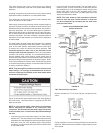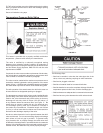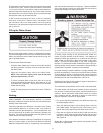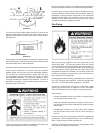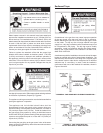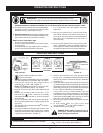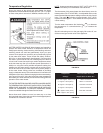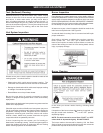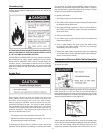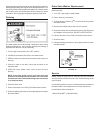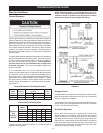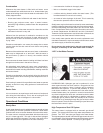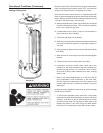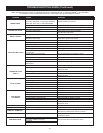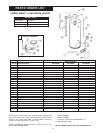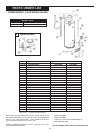
21
Housekeeping
Vacuum around base of water heater for dust, dirt, and lint on
a regular basis.
AT LEAST ONCE EVERY SIX MONTHS A VISUAL INSPECTION
SHOULD BE MADE OF THE AIR INTAKE SCREEN. CLEAN
IF LINT ACCUMULATIONS ARE NOTICED.
INSTALLED IN SUITABLE AREA: To insure sufcient ventilation
and combustion air supply, proper clearances from the water
heater must be maintained. See Facts to Consider About the
Location section. Combustible materials such as clothing,
cleaning materials, or ammable liquids, etc. must not be placed
against or adjacent to the water heater because they could
catch on re.
Anode Rod
Each heater contains at least one anode rod, which will
slowly deplete while protecting the glass-lined tank from
corrosion and prolonging the life of the water heater.
Once the anode is depleted, the tank will start to corrode,
eventually developing a leak. The use of a water softener
may decrease the life of the water heater tank. The anode
rod should be removed from the water heater tank every 3
years for inspection. The following are typical (but not all)
signs of a depleted anode rod:
• The majority of the rod’s diameter is less than 3/8”.
• Signicant sections of the support wire (approx. 1/3 or more
of the anode rod’s length) are visible.
If the anode rod shows signs of either or both it should be
replaced. NOTE: Whether re-installing or replacing the anode
rod, check for any leaks and immediately correct if found. In
situations where clearance above the water heater is limited it
may be necessary to bend the anode rod for removal. Flexible
anode rods are available for replacement.
In replacing the anode:
1. Turn off gas supply to the water heater.
2. Shut off the water supply and open a nearby hot water faucet
to depressurize the water tank.
3. Drain approximately 5 gallons of water from tank (Refer to
the “Draining and Flushing” section for proper procedures).
Close drain valve.
4. Remove old anode rod.
5. Use Teon
®
tape or approved pipe sealant on threads and
install new anode rod.
6. Turn on water supply and open nearby hot water faucet
to purge air from water system. Check for any leaks and
immediately correct any if found.
7. Restart the water heater as directed under the “Operating
Your Water Heater” section. See the “Repair Parts Illustration”
section for anode rod location.
Temperature-Pressure Relief Valve Operation
The temperature-pressure relief valve must be manually operated
at least once a year.
When checking the temperature-pressure relief valve operation,
make sure that (1) no one is in front of or around the outlet of
the temperature-pressure relief valve discharge line, and (2) that
the water discharge will not cause any property damage, as the
water may be extremely hot, see Figure 25.
FIGURE 25.
If after manually operating the valve, it fails to completely reset
and continues to release water, immediately close the cold water
inlet to the water heater, follow the draining instructions, and
replace the temperature-pressure relief valve with a new one.



